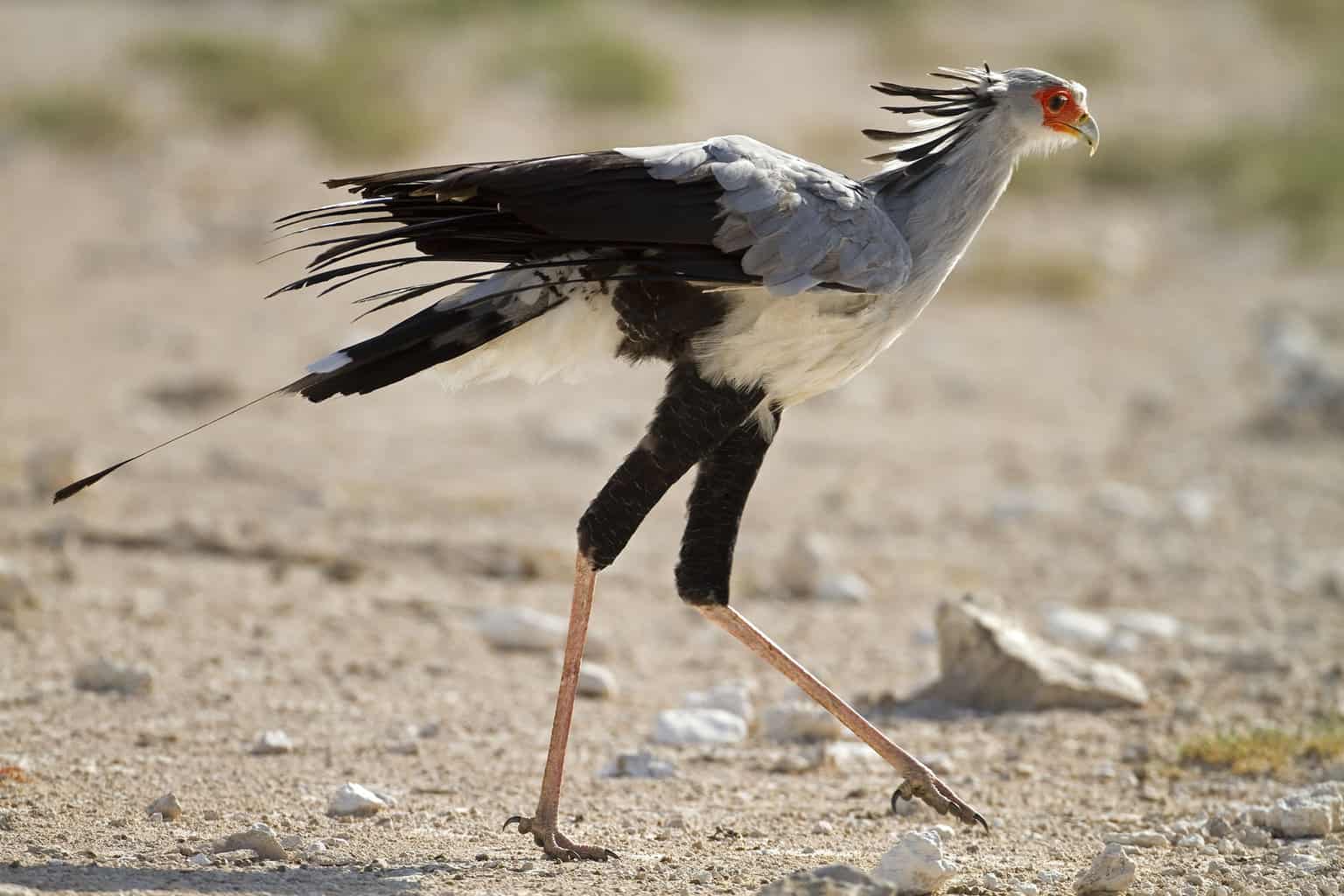When you think of birds of prey, the first birds that come to mind are probably eagles or hawks that swoop down and pick off prey in flight, but there are several terrestrial birds of prey, including caracaras and secretary birds.
The secretary bird, sometimes also spelled as one word, secretarybird, is a long-distance traveler that can put on 20 miles in one day of hunting, according to the San Diego Zoo.
They aren’t flightless, but their hunting process doesn’t involve flight, rather walking through grasslands in search of prey, which they kill with one or more swift kicks.
What Does It Look Like?
The secretary bird is a long-legged bird of prey. While the bird’s legs may be more reminiscent of a stork, its face and bill surely say bird of prey, with a slender face of orange and yellow and a sharp, curved, white bill.
At the knee, featherless lower legs meet upper legs covered in black feathers. The front half of the body is gray, with black back ends extending into long, straight tails.
The back of each bird’s head features a black crest shooting out in every direction.
It’s these patterns that some people believe originally gave secretary birds their names. More on that later.
Range, Habitat, and Migration
Secretary birds are native to sub-Saharan Africa, where they’re most common in grasslands and savannas.
While they don’t migrate, they do move around a lot in search of prey, traveling up to 20 miles in a day.
How Big Is It?
Secretary birds stand between four and five feet tall with a wingspan of seven feet, according to the Peregrine Fund.
They weigh between five and 9.5 pounds.
What Does It Eat?

They are perhaps most famous for killing and eating snakes, including venomous ones, which they kill with their lightning-fast kicks.
A study published in Current Biology in 2016 found that secretary birds’ strikes, which they can repeat in quick succession, had an impact duration of roughly 15 milliseconds and a peak force of about 5.1 times the bird’s body weight, enough to kill a snake without being bitten.
While they have gained some internet notoriety for their snake-kicking abilities due to some videos that depict them striking rubber snakes, they also eat lizards, amphibians, and invertebrates such as insects.
How Long Does It Live?
The secretary bird lives for about 10 to 15 years in the wild, with captive birds reaching 19 years, according to the San Diego Zoo.
What Does It Sound Like?
This impressive video from Stuart on Nature shows a male secretary bird chasing off a rival bird at Kgalagadi Transfrontier Park in Botswana, making a low growling noise in the process:
Conservation Status
Secretary bird populations are moving in the wrong direction in a rather quick fashion.
As recently as 2009, the species was assessed as of “least concern” on the IUCN Red List. In 2011, the species was deemed “vulnerable,” and in 2020, they were moved to the “endangered” category.
In making this distinction, the species’ assessor, BirdLife International, referenced declines throughout the species’ range in sub-Saharan Africa, with habitat loss and degradation among the potential factors.
Other Frequently Asked Questions
How Did Secretary Birds Get Their Names?
There are a couple of possible explanations offered across the web for how the secretary bird got its name.
The most common ones are often that the bird’s colors resemble a secretary’s clothes from the 18th century or that the black crest on the back of the head is similar to quill pens tucked behind someone’s ears.
Another proposed explanation is that the name is derived from Arabic.
It was suggested in the 1970s that the name is derived from the Arabic phrase “saqr et-tair,” claimed to mean either “hunting bird” or “falcon of the semi-desert.”
As Adrian Burton pointed out in 2014 in Frontiers in Ecology and the Environment, however, saqr et-tair actually translates to “falcon of the bird,” which doesn’t quite work.
According to Burton, the first official printed reference to the species was in 1769 from the Netherlands’ Arnout Vosmaer, who wrote that the Dutch settlers of southern Africa called it “secretarius,” which Vosmaer believed was a corruption of “sagittarius,” Latin for “archer.” The bird’s genus is sagittarius.
None of these explanations for the name’s genesis are universally agreed upon. If you’ve got a theory, let’s hear it.
Can Secretary Birds Fly?
Yes, secretary birds can fly, though they do much of their traveling and hunting while on foot.

